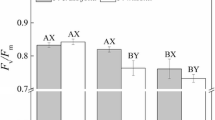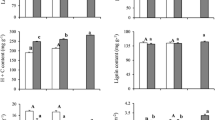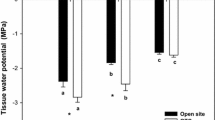Abstract
Two clones of Hevea brasiliensis (RRII 105 and PB 235) were grown for one year in two distinct agroclimatic locations (warmer and colder, W and C) in peninsular India. We simultaneously measured gas exchange and chlorophyll (Chl) fluorescence on fully mature intact leaves at different photosynthetic photon flux densities (PPFDs) and ambient CO2 concentrations (C a) and at constant ambient O2 concentration (21 %). Net photosynthetic rate (P N), apparent quantum yield for CO2 assimilation (Φc), in vivo carboxylation efficiency (CE), and photosystem 2 quantum yield (ΦPS2) were low in plants grown in C climate and these reductions were more predominant in RRII 105 than in PB 235 which was also reflected in their growth. We estimated in these clones the partitioning of photosynthetic electrons between CO2 reduction (JA) and processes other than CO2 reduction (J*) at low and high PPFDs and C a. At high C a (700 µmol mol−1) most of the photosynthetic electrons were used for CO2 assimilation and negligible amount went for other processes when PPFD was low (200–300 µmol m−2 s−1) both in the C and W climates. But at high PPFD (900-1 100 µmol m−2 s−1), J* was appreciably high even at a high C a. Hence at normal ambient C a and high irradiance, electrons can be generated in the photosynthetic apparatus far in excess of what can be safely utilised for photosynthetic CO2 reduction. However, at high C a there was increased diversion of electrons to photosynthetic CO2 reduction which resulted in improved photosynthetic parameters even in plants grown in C climate.
Similar content being viewed by others
Abbreviations
- a.s.l.:
-
above sea level
- C:
-
cold
- C a :
-
ambient atmospheric CO2 concentration
- CE:
-
in vivo carboxylation efficiency
- C i :
-
leaf intercellular CO2
- F0 :
-
minimal fluorescence at dark adapted state
- F0′:
-
minimal fluorescence obtained on far-red irradiation immediately after “actinic light” exposure
- Fm :
-
maximal fluorescence at dark adapted state
- Fm′:
-
maximal fluorescence under irradiation
- Fv/Fm :
-
ratio of variable to maximum fluorescence obtained after 20 min dark adaptation of the leaves
- Ft :
-
fluorescence at steady state
- Fv′/Fm′:
-
efficiency of excitation energy capture by open PS2 reaction centre
- IRGA:
-
infra-red gas analysis
- JA :
-
rate of electron flow to CO2 assimilation
- JT :
-
rate of non-cyclic electron flow across PS2
- J* :
-
rate of electron flow to processes other than CO2 reduction
- PAM:
-
pulse amplitude modulated
- P max(Ci) :
-
C i saturated CO2 assimilation rate
- Pmax(PPFD) :
-
PPFD saturated CO2 assimilation rate
- P N :
-
net photosynthetic rate
- PPFD:
-
photosynthetic photon flux density
- qN :
-
non-photochemical quenching
- qP :
-
photochemical quenching
- ROS:
-
reactive oxygen species
- VPD:
-
vapour pressure deficit
- W:
-
warm
- Φc :
-
apparent quantum yield for CO2 assimilation
- ΦPS2 :
-
effective PS2 quantum yield
References
Adams, W.W., Demmig-Adams, B., Verhoeven, A.S., Barker, D.H.: Photoinhibition during winter stress: involvement of sustained energy dissipation. — Aust. J. Plant Physiol. 22: 261–276, 1995.
Alam, B., Jacob, J.: Overproduction of photosynthetic electrons is associated with chilling injury in green leaves. — Photosynthetica 40: 91–95, 2002.
Allen, D.J., Ort, D.R.: Impacts of chilling temperatures on photosynthesis in warm-climate plants. — Trends Plant Sci. 6: 36–42, 2001.
Aro, E.-M., Virgin I., Andersson, B.: Photoinhibition of photosystem II. Inactivation, protein damage and turnover. — Biochim. biophys. Acta 1143: 113–134, 1993.
Azevedo, R.A., Alas, R.M., Smith, R.J., Lea, P.J.: Response of antioxidant enzymes to transfer from elevated carbon dioxide to air and ozone fumigation, in the leaves and roots of wild-type and a catalase-deficient mutant of barley. — Physiol. Plant. 104: 280–292, 1998.
Baker, N.R.: Chilling stress and photosynthesis. — In: Foyer, C.H., Mullineaux, P.M. (ed.): Causes of Photooxidative Stress and Amelioration of Defence Systems in Plants. Pp. 127–154. CRC Press, Boca Raton 1994.
Barber, J., Andersson, B.: Too much of a good thing: light can be bad for photosynthesis. — Trends biochem. Sci. 17: 61–66, 1992.
Caemmerer, S. von, Farquhar, G.D.: Some relationships between the biochemistry of photosynthesis and the gas exchange of leaves. — Planta 153: 376–387, 1981.
Cheng, L., Fuchigami, L.H., Breen, P.J.: The relationship between photosystem II efficiency and quantum yield for CO2 assimilation is not affected by nitrogen content in apple leaves. — J. exp. Bot. 52: 1865–1872, 2001.
Devakumar, A.S, Jacob, J.: Growth and development of plants in a CO2 enriched world. — Agro’s annu. Rev. Plant Physiol. 1997: 281–317, 1997.
Devakumar, A.S., Sathik, M.B.M., Sreelatha, S., Thapliyal, A.P., Jacob, J.:. Photosynthesis in mature trees of Hevea brasiliensis experiencing drought and cold stresses concomitant with high light in the field. — Indian J. nat. Rubber Res. 15: 1–13, 2002.
Fryer, M.J., Andrews, J.R., Oxbrough, K., Blowers, D.A., Baker, N.R.: Relationship between CO2 assimilation, photosynthetic electron transport and active O2 metabolism in leaves of maize in the field during periods of low temperature. — Plant Physiol. 116: 571–580, 1998.
Genty, B., Briantais, J.-M., Baker, N.R.: The relationship between the quantum yield of photosynthetic electron transport and quenching of chlorophyll fluorescence. — Biochim. biophys. Acta 990: 87–92, 1989.
Holaday, A.S., Martindale, W., Alred, R., Brooks, A.L., Leegood, R.C.: Changes in activities of enzymes of carbon metabolism in leaves during exposure of plants to low temperature. — Plant Physiol. 98: 1105–1114, 1992.
Huner, N.P.A., Oquist, G., Hurry, V.M., Krol, M., Falk, S., Griffith, M.: Photosynthesis, photoinhibition and low temperature acclimation in cold tolerant plants. — Photosynth. Res. 137: 19–39, 1993.
Huner, N.P.A., Oquist, G., Sarhan, F.: Energy balance and acclimation to light and cold. — Trends Plant Sci. 3: 224–230, 1998.
Jacob, J., Annamalainathan, K., Alam, B., Sathik, M.B.M., Thapliyal, A.P., Devakumar, A.S.: Physiological constraints for cultivation of Hevea brasiliensis in certain unfavourable agroclimatic regions of India. — Indian J. nat. Rubber Res. 12: 1–16, 1999.
Long, S.P., Humphries, S., Falkowski, P.G.: Photoinhibition of photosynthesis in nature. — Annu. Rev. Plant Physiol. Plant mol. Biol. 45: 633–662, 1994.
Morison, J.I.L., Lawlor, D.W.: Interactions between increasing CO2 concentration and temperature on plant growth. — Plant Cell Environ. 22: 659–682, 1999.
Polle, A., Eiblmeir, M., Sheppard, L., Murray, M.: Responses of antioxidant enzymes to elevated CO2 in leaves of beech (Fagus sylvatica L.) seedlings grown under a range of nutrient regimes. — Plant Cell Environ. 20: 1317–1321, 1996.
Ray, D., Dey, S.K., Das, G.: Significance of the leaf area ratio in Hevea brasiliensis under high irradiance and low temperature stress. — Photosynthetica 42: 93–97, 2004.
Rubber Grower’s Companion. — Rubber Research Institute of India, Kottayam 1995.
Schreiber, U., Bilger, W., Hormann, H., Neubauer, C.: Chlorophyll fluorescence as a diagnostic tool: basics and some aspects of practical relevance. — In: Raghavendra, A.S. (ed.): Photosynthesis: A Comprehensive Treatise. Pp. 320–336. Cambridge University Press, Cambridge 1998.
Schwanz, P., Kimball, B.A., Idso, S.B., Hendrix, D.L., Polle, A.: Antioxidants in sun and shade leaves of sour orange trees (Citrus aurantium) after long-term acclimation to elevated CO2. — J. exp. Bot. 47: 1941–1950, 1996.
Schwanz, P., Polle, A.: Differential stress responses of antioxidative systems to drought in pendunculate oak (Quercus robur) and maritime pine (Pinus pinaster) grown under high CO2 concentrations. — J. exp. Bot. 52: 133–143, 2001.
Streb, P., Shang, W., Feirabend, J., Bligny, R.: Divergent strategies of photoprotection in high-mountain plants. — Planta 207: 313–324, 1998.
Author information
Authors and Affiliations
Rights and permissions
About this article
Cite this article
Alam, B., Nair, D.B. & Jacob, J. Low temperature stress modifies the photochemical efficiency of a tropical tree species Hevea brasiliensis: effects of varying concentration of CO2 and photon flux density. Photosynthetica 43, 247–252 (2005). https://doi.org/10.1007/s11099-005-0040-z
Received:
Accepted:
Issue Date:
DOI: https://doi.org/10.1007/s11099-005-0040-z




